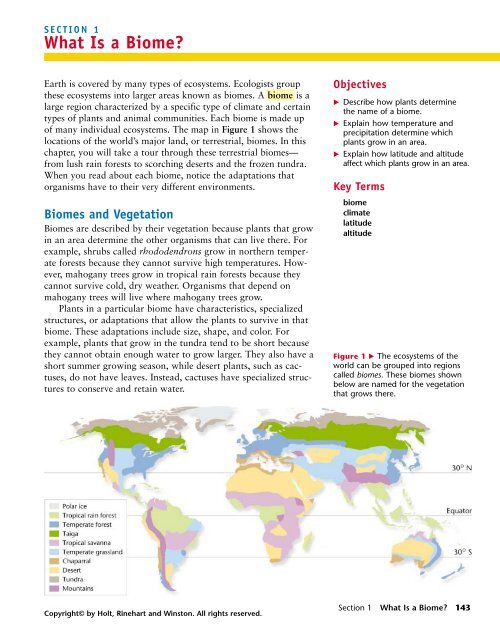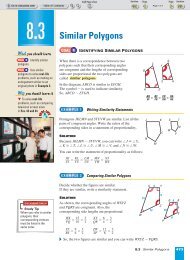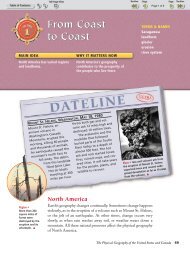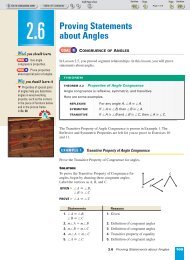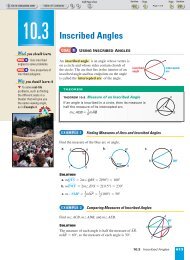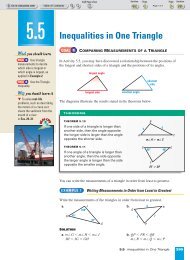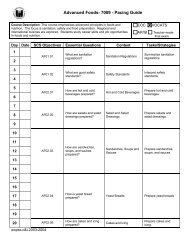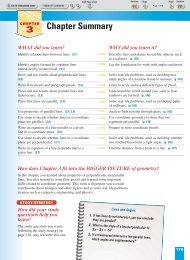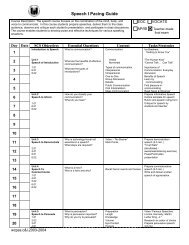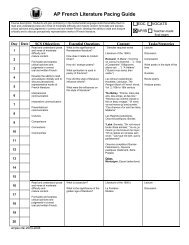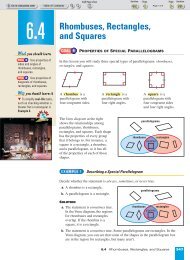Section 1 What Is a Biome? - Nexuslearning.net
Section 1 What Is a Biome? - Nexuslearning.net
Section 1 What Is a Biome? - Nexuslearning.net
Create successful ePaper yourself
Turn your PDF publications into a flip-book with our unique Google optimized e-Paper software.
SECTION 1<br />
<strong>What</strong> <strong>Is</strong> a <strong>Biome</strong>?<br />
Earth is covered by many types of ecosystems. Ecologists group<br />
these ecosystems into larger areas known as biomes. A biome is a<br />
large region characterized by a specific type of climate and certain<br />
types of plants and animal communities. Each biome is made up<br />
of many individual ecosystems. The map in Figure 1 shows the<br />
locations of the world’s major land, or terrestrial, biomes. In this<br />
chapter, you will take a tour through these terrestrial biomes—<br />
from lush rain forests to scorching deserts and the frozen tundra.<br />
When you read about each biome, notice the adaptations that<br />
organisms have to their very different environments.<br />
<strong>Biome</strong>s and Vegetation<br />
<strong>Biome</strong>s are described by their vegetation because plants that grow<br />
in an area determine the other organisms that can live there. For<br />
example, shrubs called rhododendrons grow in northern temperate<br />
forests because they cannot survive high temperatures. However,<br />
mahogany trees grow in tropical rain forests because they<br />
cannot survive cold, dry weather. Organisms that depend on<br />
mahogany trees will live where mahogany trees grow.<br />
Plants in a particular biome have characteristics, specialized<br />
structures, or adaptations that allow the plants to survive in that<br />
biome. These adaptations include size, shape, and color. For<br />
example, plants that grow in the tundra tend to be short because<br />
they cannot obtain enough water to grow larger. They also have a<br />
short summer growing season, while desert plants, such as cactuses,<br />
do not have leaves. Instead, cactuses have specialized structures<br />
to conserve and retain water.<br />
Copyright© by Holt, Rinehart and Winston. All rights reserved.<br />
Objectives<br />
Describe how plants determine<br />
the name of a biome.<br />
Explain how temperature and<br />
precipitation determine which<br />
plants grow in an area.<br />
Explain how latitude and altitude<br />
affect which plants grow in an area.<br />
Key Terms<br />
biome<br />
climate<br />
latitude<br />
altitude<br />
Figure 1 The ecosystems of the<br />
world can be grouped into regions<br />
called biomes. These biomes shown<br />
below are named for the vegetation<br />
that grows there.<br />
<strong>Section</strong> 1 <strong>What</strong> <strong>Is</strong> a <strong>Biome</strong>? 143


